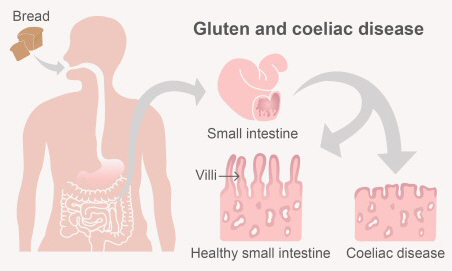Coeliac disease Tirohanga whānui ki te mate witi-kore
Coeliac disease is a condition where your immune system attacks your own body when you eat gluten. This damages your gut (small intestine) so it is important to avoid foods and drinks containing gluten.
Causes of coeliac disease
Coeliac disease is a lifelong condition where your body mistakes gluten for a harmful substance. Gluten is a protein found in wheat, rye, barley and oats.
Your small intestine (small bowel) is lined with tiny finger-like projections called villi. Villi break down and absorb nutrients in your food. If you have coeliac disease, gluten damages the villi. They become flattened and the surface area of your intestine decreases, This means you may not be able to absorb enough vitamins and minerals from your food.

Coeliac disease can develop at any stage in life. It affects about 1% of New Zealanders. If you have a close relative (parent, brother, sister or child) with the disease, you will have a 10% chance of developing it too.
Coeliac disease in children — KidsHealth
You can watch a video where people with Coeliac disease discuss their condition.
Symptoms of coeliac disease
Many people with coeliac disease have no obvious symptoms. Some people may have some of these symptoms:
- fatigue, weakness and lethargy
- runny poos (diarrhoea), hard poos (constipation), stomach pain, bloating and excessive farting
- weight loss
- feeling sick (nausea) and throwing up (vomiting).
Diagnosing coeliac disease
Your healthcare provider will ask you about your symptoms. They will also discuss your family history and overall health and lifestyle.
If they think you might have coeliac disease, you will need to have a screening blood test. If this test shows you might have coeliac disease, you will be offered a procedure called a gastroscopy to confirm the diagnosis.
In a gastroscopy, a small, flexible tube with a camera is passed through your mouth, food pipe (oesophagus), stomach and into your small intestine. You will not need to be put to sleep (a general anaesthetic) but you can have a sedative to help you relax. You will be able to go home the same day.
If you cannot or choose not to have a gastroscopy, you may be diagnosed without one if blood tests strongly suggest you have coeliac disease.
Delay going gluten free
Do not start a gluten-free diet until you have been diagnosed with coeliac disease. This is because you need to be eating gluten to get accurate test results. If you have been on a gluten-free diet, you will need to return to a normal diet for 6 weeks before testing. During this time, you will need to eat at least 4 slices of wheat-based bread (or equivalent) every day.
Use the guide below for the types and amounts of gluten-containing foods you should eat for accurate coeliac disease testing.
For coeliac disease testing to be reliable, you will first need to do the gluten challenge for 6 weeks. This means you need to eat 8 to 10 grams of gluten (4 to 5 grams for children) every day. Each of the foods on this list provides 2 to 2.5 grams of gluten per serving.
- 1 slice wheat-based bread
- half a cup of cooked wheat-based pasta
- one third of a cup of cooked couscous
- 4 to 5 single Salada or Vita-Weat crackers
- half a large or one small bread roll
- 1 Weet-bix or other cereal biscuit
- half a cup of wheat-based cereal
- 2 small sweet biscuits
- 1 slice of cake or 1 small (30 grams) muffin
Treating celiac disease
There is no cure for coeliac disease. The only effective treatment is to follow a strict gluten-free diet. You will need to do this for the rest of your life, even if you do not have any symptoms caused by eating gluten.
Following a gluten-free diet can be overwhelming to start with. Your healthcare provider or specialist will refer you to a dietitian who can help you get started. They can make sure you have the right information to follow a healthy and nutritious gluten-free diet.
When you stop eating gluten, the inflammation in your small intestine goes away and the villi regrow. This means you can absorb the nutrients in food properly and any symptoms you have get better.
Eating gluten-free for coeliac disease
Eating foods containing even tiny amounts of gluten is enough to damage your small intestine and cause unpleasant gut symptoms.
Regularly eating small amounts of gluten when you have coeliac disease increases your risk of developing complications such as thin and weak bones (osteoporosis) and some types of cancer
Self care for celiac disease
There are several things you can do to help yourself if you have coeliac disease.
- Learn about your condition and how to eat gluten-free.
- Take nutrition supplements prescribed by your healthcare provider. Some people with coeliac disease have low levels of nutrients when they are first diagnosed. These can include iron, folate, vitamin D and vitamin B12. When your blood levels have returned to normal and your small intestine is able to absorb nutrients properly again, you will no longer need to take supplements.
- Check that any medications and supplements you take are gluten-free. If you are unsure, talk to a pharmacist.
- Keep physically active. This is one of the best things you can do for your health. Aim for at least 30 minutes of activity most days.
Being physically active - Have a check-up with your healthcare provider once a year. They will check your general health, do blood tests and discuss any concerns. You may be sent for a bone density scan to check for osteoporosis.
Osteoporosis - Join Coeliac New Zealand. This organisation works to provide support and resources to people with coeliac disease and their whānau.